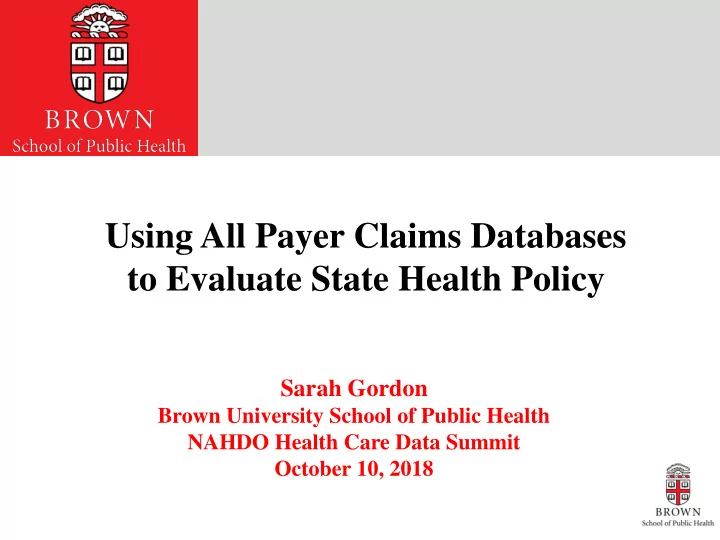

Using All Payer Claims Databases to Evaluate State Health Policy Sarah Gordon Brown University School of Public Health NAHDO Health Care Data Summit October 10, 2018
Acknowledgements Co-authors: Ira Wilson, Omar Galarraga, Amal Trivedi, Benjamin Sommers Funding: Agency for Healthcare Research and Quality R36 Dissertation Award Data Partners: Colorado Center for Improving Value in Healthcare (CIVHC) and Utah Department of Health
Outline 1. Objective of studies 2. Process of obtaining all payer data 3. Study findings 4. Strengths and limitations of data 5. Suggestions for data improvements for academic use of APCDs
Research Objectives 1. Examine the frequency of early Marketplace dropout and assess predictors of disenrollment (Colorado only) 2. Evaluate the impact of Medicaid expansion on continuity of Medicaid coverage (Colorado and Utah)
Why APCDs? High rates of movement in between types of insurance was predicted under the Affordable Care Act, but there is limited empirical work that verifies these forecasts All payer claims databases are the only way to examine this question using administrative data
Obtaining All Payer Data Used APCD Council website to identify states that had active APCDs Emailed every state and asked specifically about: 1. Ability of state APCD to track patients as they transition between insurance sources and care settings 2. Observation of claim-level encounters in order to measure health status and utilization outcomes 3. Cost and access to data for researchers
ACA Insurance Expansions
Study #1: Disenrollment from the Colorado Marketplace How many people leave Marketplace coverage early? Who are they? Are they high-cost enrollees? What factors are predictive of early disenrollment?
Data and Methods Data Source: Colorado APCD, 2014-2016 Sample: 307,937 person-years of Colorado Marketplace ages, excluding dental and grandfathered plans Study Design: Longitudinal survival analysis examining predictors of early disenrollment from Marketplace coverage Primary outcome: Disenrollment within the calendar year
Results Nearly 1 in 4 Marketplace beneficiaries disenrolled within twelve months of their coverage start date Drop-out highest among bronze enrollees and lowest among silver enrollees receiving CSRs
Survival Curve of Marketplace Enrollment by Actuarial Value 1.00 0.70 0 100 200 300 400 Months Since Enrollment Bronze Silver No Cost-Sharing Reductions Silver Income 200-250% FPL Silver Income 100-150% FPL Silver Income 100-150% FPL Gold
Results Younger adults were more likely to disenroll than older adults, as were those living in ZIP codes with greater proportion of minority residents Switching between insurance occurred at lower rates than predicted – 10.4% transitioned to Medicaid – >17% transitioned to commercial coverage Those who disenrolled early had higher monthly utilization rates of ED and inpatient, but not office visits
Data Strengths Ability to: – identify who received cost-sharing reductions using actuarial values – track churning between Marketplace and Medicaid and verify pre-ACA predictions – understand demographics and health care costs of those who leave Marketplace First study examining drop-out from Marketplace – Cost, access, and utilization implications for regulators and insurers
Data Limitations Comprehensiveness – Lack of self-insured data – Reduces precision of estimates of transitions to commercial coverage Potential for selection bias – Missing race/ethnicity, socioeconomic measures – Missing Marketplace plan information and receipt of premium subsidies Generalizability – One state
Study #2: Impact of Medicaid Expansion on Continuity of Coverage Did Medicaid expansion under the ACA increase enrollment duration and reduce coverage disruptions?
Why Continuity of Medicaid Coverage? Churning is associated with poor health outcomes, disruptions in continuity of care, and increased financial exposure to out-of-pocket costs Churning is administratively costly for state Medicaid departments and is associated with care in higher-cost settings
Data and Methods Data Source: Colorado and Utah APCDs, 2013-2015 Sample: 349,537 individuals 18-62 who were enrolled in Medicaid in 2013 Primary outcomes: Number of months of Medicaid coverage and probability of coverage disruption
Results: Rates of Disenrollment and Gaps among Medicaid Enrollees in Colorado and Utah, 2013-2015 60.0 Proportion of Medicaid Enrollees with 50.0 3.2 Coverage Disruptions 40.0 5.7 30.0 6.0 Gap in Coverage 7.0 Disenrollment 44.6 20.0 34.5 26.9 21.5 2.4 10.0 2.5 9.6 7.7 0.0 2013 2014 2015 2013 2014 2015 Year Utah Colorado
Data Strengths Vendor Consistency – Agreement across variable definition and data structure Monthly enrollment data – First study to examine impact of ACA on continuity of coverage in Medicaid using administrative data Ability to observe insurance transitions*
Data Limitations Lost to follow up does not mean uninsured – Self-insured plans, deceased, VA, IHS, government employees, moved out of state, unobserved plans or enrollees – Ability to observe insurance transitions limited by missing self-insured data Missing Marketplace data – No flag for Marketplace plans in UT APCD
In a Perfect World…. 1. Incentives or regulation for self-insured plans to opt in 2. Flag for uninsured or self-pay utilization 3. More complete race/ethnicity, income, and other demographic data 4. Uniform datasets across states 5. Ability to identify Marketplace plans, plan information, receipt of premium subsidies
In Reality…. 1. Clear, concise data element dictionaries and explanation of limitations 2. Uniform variable labeling 3. Improved precision in estimates of who APCD does not capture 4. Dissemination of APCD findings
Conclusions APCDs hold great promise for collaborations between states and academic researchers – Cost trends, Marketplace and Medicaid data, transparency, quality Data limitations pose barriers, but cross-state research can still be done with important contributions to literature
Recommend
More recommend